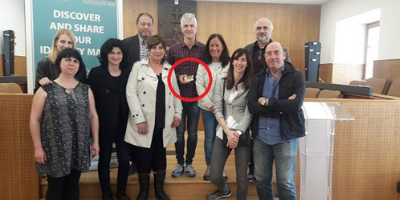When we visited the mayor Curiosity killed the cat !!
Have you realised our mayor is holding a packet of chewing gum? Would you like to know why? If you keep on reading this article , you will find all the answers to these questions.
Chios mastic (Mastiha de Chios), whose label of Protected Designation of Origin comes from 1997. It is a natural aromatic resin, in the shape of a tear, that comes from a tree originating from this Aegean island belonging to the family of pistachia.
The mastic tree grows only in 21 villages in the south of the island of Chios and it is totally related to the wheather condition.
This island has an excellent warm and dry climate. Chios is the only place in the world where the trunk and the branches of the mastija throw tears. The mastija drops them after the incisions made in the trunk of the tree. A viscous transparent liquid appears in its secretion At first, the taste is bitter but, quickly, it acquires a unique aroma.
The product, once solidified, is collected and cleaned, giving us the Chitos mastic in its natural form
Its production requires a long and hard work throughout the year. The first reference to the mastija comes to us from the historian Herodoto from V a.C who said that n Classical Greece it was used as a natural tooth whitening, that is, it was the only chewing gum of the Ancient Greeks.
Since ancient times, doctors, such as Hippocrates, Galinos or Dioskuridis, had discovered their therapeutic virtues.
The mastija is good for digestion, it helps oral hygiene, kills germs, has antioxidant and anti-inflammatory properties and makes cholesterol dissapear.
The cultivation of the mastija, due to the special knowledge it requires, has been included among the candidatures which will be evaluated by Unesco to be inscribed in the Representative List of the Intangible cultural heritage of humanity




24/05/2019 @ 13:25
Interesting!!! I had no idea that Greek gum had behind so many curiosities….